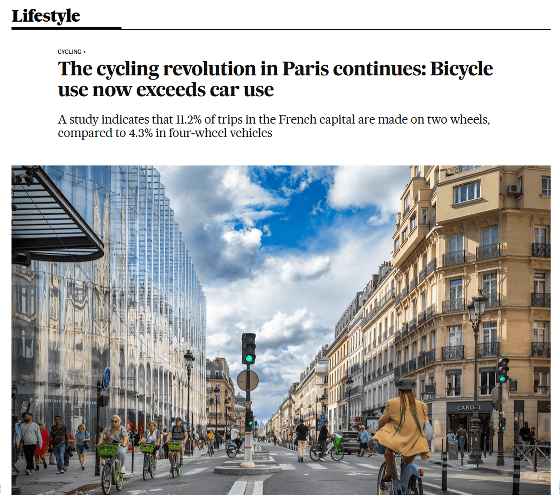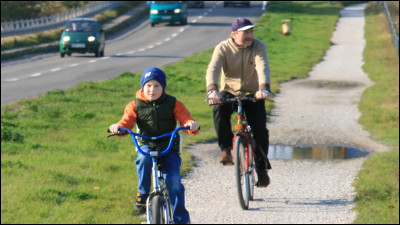In Paris, where a bicycle promotion plan is underway, bicycles have surpassed cars in terms of share of transportation modes.

In Paris, France, Mayor
The cycling revolution in Paris continues: Bicycle use now exceeds car use | Lifestyle | EL PAÍS English
https://english.elpais.com/lifestyle/2024-04-24/the-cycling-revolution-in-paris-continues-bicycle-use-now-exceeds-car-use.html

Rue de Rivoli in central Paris is a major traffic artery that passes in front of the Paris City Hall and the Louvre Museum . During rush hour, it is crowded with tourists and commuters, and about five years ago, it was almost entirely filled with cars.
However, in recent years, Mayor Hidalgo has been promoting policies to support bicycle transportation in Paris, and two-way bicycle lanes have been created on the Rue de Rivoli. As a result, the Rue de Rivoli is now a place where many bicycles can be seen during rush hour.
The bicycle reform has led to a situation where bicycle lanes are jammed on sunny days due to the high density of bicycles, and bicycles sometimes even collide with each other. Mayor Hidalgo is trying to improve this situation by installing bicycle lanes on the streets parallel to the Rue de Rivoli.

According to the latest municipal data from Paris, the total length of roads in Paris where bicycles can travel has reached 1,000 km, of which more than 300 km are bicycle-only lanes. Paris authorities want to make the entire city suitable for bicycle travel by 2026, and Mayor Hidalgo, who is serving her second term from 2020, has secured $250 million (about 38.9 billion yen), $100 million more than in the previous term, for bicycle reform.
However,
The number of bicycles already exceeds the number of cars on some major streets, and Paris' municipal bicycle rental service, Vélib , has introduced 3,000 new bicycles since March 2024 alone. A 62-year-old woman who has lived in Paris for many years commented that in the early 1980s, it was very dangerous to travel by bicycle, but in recent years, even women can ride bicycles safely.
According to a survey by the Paris Région Institute , an urban planning organization in Paris, 11.2% of the means of transportation used for travel in Paris from 2022 to 2023 were bicycles, while cars accounted for only 4.3%. In 2021, bicycles accounted for 5.6% and cars for 9%, indicating a significant increase in bicycle users in just one or two years.
The survey also found that not only Parisians but also residents of the suburbs prefer to use bicycles, with 14% of trips being by bicycle and 11.8% by car. This trend is even more pronounced during rush hour, when 18.9% of trips are by bicycle and 6.6% by car.

The increase in bicycle use in Paris is due to the public transport strike in December 2019 to protest against the government's pension reforms and the city lockdown due to the COVID-19 pandemic. According to Paris City Hall, car traffic in the city has decreased by 40% over the past 12 years.
However, the sudden change in transportation methods has also caused various frictions and confusion. Mayor Hidalgo also acknowledged this point, saying, 'Such a sudden change in habits is accompanied by tensions on the street. It takes time for everyone to find their place and feel safe,' and argued that cyclists should be aware that they are using public space and follow the rules. In the summer of 2023, posters will be posted all over the city to promote rules such as 'pedestrians have priority on the road' and 'maximum speed is 30 km/h.'
In the future, Paris authorities plan to improve infrastructure to accommodate the increasing number of cyclists, including plans to increase the number of bicycle parking spaces in the city to more than 130,000 spaces.
Related Posts:
in Ride, Posted by log1h_ik







